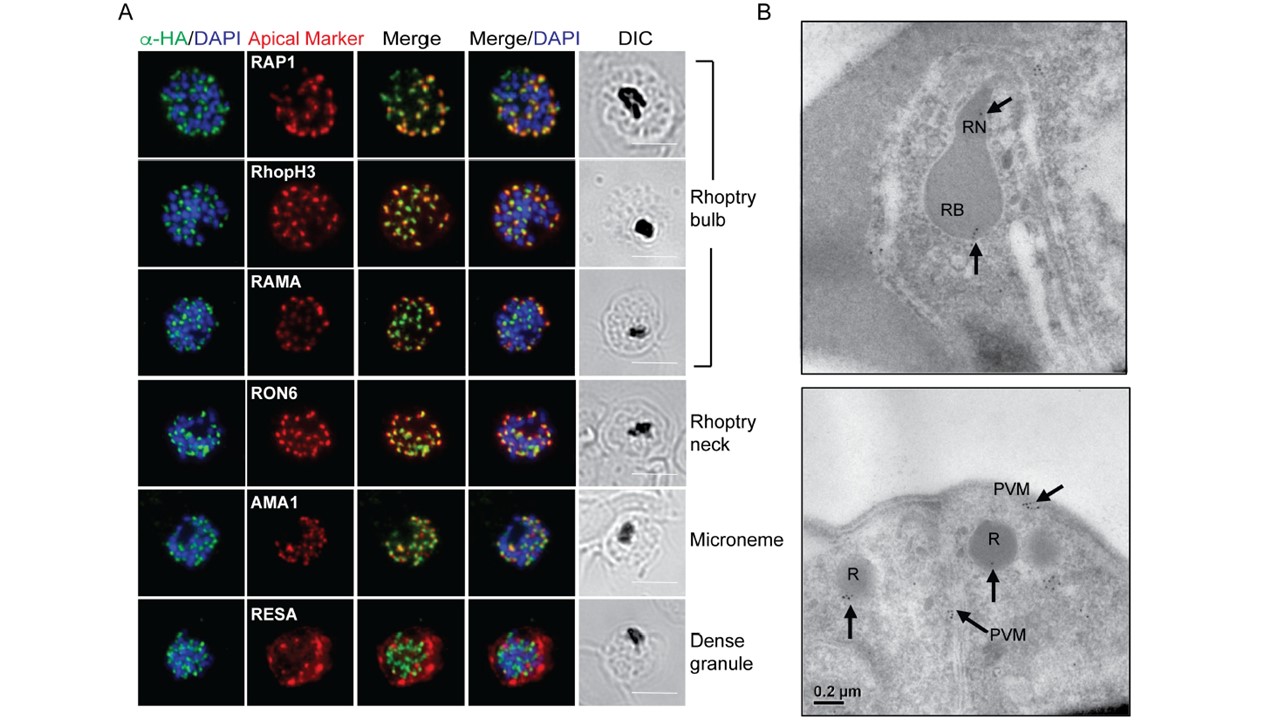The localization of DPAP3 is distinct from proteins that localize to the apical organelles. A. IFA on RBCs infected with PfDPAP3-HAglmS parasites and fixed with acetone/methanol. DPAP3 is labeled with the anti-HA antibody. The scale bars represent 5 μm. Co-localization studies were performed with antibodies to proteins that reside in apical organelles, namely RAMA, RAP1 and RhopH3, which reside in the rhoptry bulb; RON6, which resides in the rhoptry neck; AMA1, which resides in the micronemes and RESA, which localises to the dense granules. DPAP3 did not co-localise with any of these proteins (A). Rather it showed partial
co-localisation with rhoptry and microneme markers but no co-localisation with the dense granule marker RESA. This indicates that DPAP3 may not be housed in any of these three Plasmodium apical organelles, but potentially in secretory vesicles in close proximity to the rhoptries and micronemes.B. Immuno-electron microscopy of PfDPAP3-HAglmS parasites with anti-HA antibody shows labelling for DPAP3 (as indicated by the arrowheads) in a mature schizont at the periphery of the rhoptry bulb (RB), rhoptry neck (RN) as well as at the PV/parasitophorous vacuole membrane (PVM). DPAP3 was observed at multiple locations in the parasites, including towards the periphery of rhoptry bulb and neck, in other apical regions and also at the parasitophorous vacuole membrane (PVM)
Ghosh S, Chisholm SA, Dans M, Lakkavaram A, Kennedy K, Ralph SA, Counihan NA, de Koning-Ward TF. The cysteine protease dipeptidyl aminopeptidase 3 does not contribute to egress of Plasmodium falciparum from host red blood cells. PLoS One. 2018 13(3):e0193538.
Other associated proteins
| PFID | Formal Annotation |
|---|---|
| PF3D7_0102200 | ring-infected erythrocyte surface antigen |
| PF3D7_0404700 | dipeptidyl aminopeptidase 3 |
| PF3D7_0707300 | rhoptry-associated membrane antigen |
| PF3D7_0905400 | high molecular weight rhoptry protein 3 |
| PF3D7_1133400 | apical membrane antigen 1 |
| PF3D7_1410400 | rhoptry-associated protein 1 |
